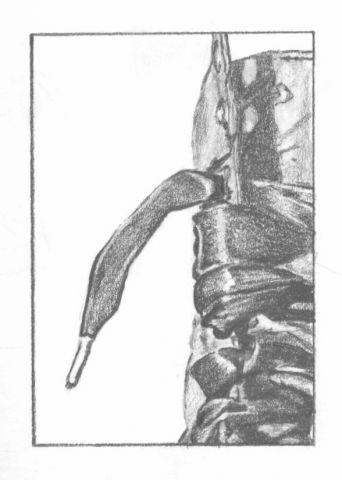Here is my statement so far for my new body of work;
With this body of work I intend to explore the practice and processes of drawing, showing the subject in various styles from simple outlines through to quite technical and accurate reproductions through to more abstract and expressive work. I want to show the importance of having the ability to draw and continuing the practice of drawing beyond art school.
The subject of each individual piece is identical but unimportant. Some of the drawings are intentionally abstract but the viewer is fully informed as to what the subject is by studying the other pieces in the series. The stages show examples of drawing processes that any student of art would be shown during their time at art school. From the beginning stages of learning to believe what you see (not what you think you should see) and the importance of looking at your subject, with ‘blind’ drawings and measured drawings, to ways of introducing the idea of tone and form using such techniques as weight of line and mapping. The earlier stages are what would be considered to be the foundations of drawing and these techniques will later inform more experimental ideas of drawing and even begin to question traditional views of what constitutes a drawing.Initially the materials I have used are pencil and pen and the processes have been fairly methodical, creating drawings with a technical approach. The next stage is to work with charcoal, creating looser more expressive drawings leading onto more abstract work. After this my intention is to move into using other materials such as paint and 3D form to explore further the idea of drawing and what can be classed as a drawing.
Reproducing varied pieces with similar subjects is not a new idea. Looking back at the work of the well known artist Mondrian, we can see an artist creating various abstract images that are sometimes wildly obscure. Our appreciation of these images and his abilities as an artist is informed by his ability to beautifully reproduce life accurately in earlier drawings.I was influenced originally by the still life drawing by de Kooning from his days at art school; this made me start to think of the importance of having these skills. de Kooning is known for his abstract work, however this drawing shows that his technical ability was second to none. But how important is this and how does it, if at all affect the work of an artist? Was it necessary for him to produce drawings such as this in his early life as an artist to then go on to produce the work he is known for?Displaying all the stages of drawing together as one piece of work, from the technical to those that are in my own style and express something of me, I intend to show the breadth and depth of the subject of drawing, and for the viewer to question if the earlier work is necessary or important for the later work (or even the opposite way round).
I think that this body of work raises the questions; – Do we need to go through the processes of learning to draw traditionally to then produce abstract art of any worth? – How important is it to an artist to have these technical abilities and how much does practice like this effect and inform later work. Is it necessary to go though all this to grow as an artist and to become the best you can be?As far as the audience is concerned, does it matter to them, is abstract art viewed differently if it is know that the artist does have excellent technical ability? Does it have more value and respect as a work of art? To see images of the work so far please go to jenniferbennettart.blogspot.comComments on the work and statement would be greatly appreciated!
Learning to draw again
0
Comments
